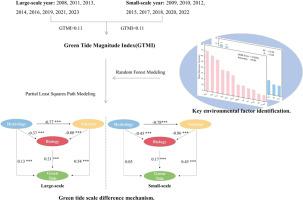营养竞争、生物相互作用和水文调节的协同效应驱动了南黄海绿潮的爆发
IF 4.5
1区 生物学
Q1 MARINE & FRESHWATER BIOLOGY
引用次数: 0
摘要
绿潮可作为沿海生态系统失衡的指标,但其年际变化及其驱动机制尚不清楚。本文建立了综合绿潮强度指数(GTMI),将2008-2023年南黄海绿潮事件定量划分为大、小量级年。通过将季节趋势分解(STL)和随机森林回归(RFR)相结合,系统地分解时间序列的趋势和季节成分,同时保持其完整性,显著提高了对关键环境因子的解释能力。结果表明,硅酸盐、盐度、硝酸盐和海面温度是影响绿潮爆发幅度和周期变化的关键控制因素。偏最小二乘路径模型(PLS-PM)揭示了涉及养分竞争、生物相互作用和水文调节的潜在机制。Ulva与浮游植物之间的养分重叠引发资源排斥,使Ulva通过生态位抢占占据主导地位,抑制浮游植物生长,而水文力量放大了Ulva的扩张和抑制作用。GTMI提供了一个定量评估工具,STL-RF-PLS框架推进了对多因素驱动因素的机制理解,为区域绿潮缓解和沿海生态系统管理提供了重要见解。本文章由计算机程序翻译,如有差异,请以英文原文为准。

Synergistic effects of nutrient competition, biotic interactions, and hydrological regulation drive green tide outbreaks in the South Yellow Sea
Green tides serve as indicators of coastal ecosystem imbalance, yet their interannual variability and driving mechanisms remain poorly characterized. This study develops the Comprehensive Green Tide Magnitude Index (GTMI) to quantitatively classify South Yellow Sea green tide events (2008–2023) into large- and small-magnitude years. By integrating Seasonal-Trend decomposition (STL) and Random Forest Regression (RFR), we systematically decompose the trend and seasonal components of the time series while preserving its integrity, significantly enhancing the ability to interpret key environmental factors. The results identify silicate, salinity, nitrate, and sea surface temperature as key controlling factors influencing both the magnitude and periodic variability of green tide outbreaks. A partial least squares path model (PLS-PM) reveals a potential mechanism involving nutrient competition, biological interaction, and hydrological regulation. Nutrient overlap between Ulva and phytoplankton triggers resource exclusion, enabling Ulva to dominate through niche preemption and suppress phytoplankton growth, while hydrological forces amplify Ulva expansion and inhibitory effects. The GTMI provides a quantitative assessment tool, and the STL-RF-PLS framework advances mechanistic understanding of multifactorial drivers, offering critical insights for regional green tide mitigation and coastal ecosystem management.
求助全文
通过发布文献求助,成功后即可免费获取论文全文。
去求助
来源期刊

Harmful Algae
生物-海洋与淡水生物学
CiteScore
12.50
自引率
15.20%
发文量
122
审稿时长
7.5 months
期刊介绍:
This journal provides a forum to promote knowledge of harmful microalgae and macroalgae, including cyanobacteria, as well as monitoring, management and control of these organisms.
 求助内容:
求助内容: 应助结果提醒方式:
应助结果提醒方式:


